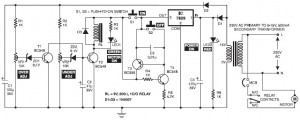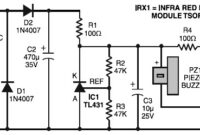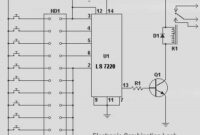The above diagram is the schematic diagram of an electronic motor starter circuit. This motor starter protects singlephase motors against voltage fluctuations and overloading. Its salient function is a soft on/off electronic switch for simple operation.
The transformer steps down the AC voltage from 230V to 15V. Diodes D1 and D2 rectify the AC voltage to DC. The unregulated power supply is given towards the protection circuit. Inside the protection circuit, transistor T1 is utilized to defend the motor from over-voltage.
The over-voltage setting is performed working with preset VR1 such that T1 conducts when voltages goes beyond upper limit (say, 260V). When T1 conducts, it switches off T2. Transistor T2 works as the under-voltage protector. The under-voltage setting is performed using the support of preset VR2 such that T2 stops conducting when voltage is below lower limit (say, 180V). Zener diodes ZD1 and ZD2 deliver base bias to transistors T1 and T2, respectively. Transistors T3 and T4 are connected back to back to form an SCR configuration, which behaves as an “on”/”off” control. Switch S1 is utilized to turn on the pump, whilst switch S2 is utilized to turn off the pump.
Whilst generating over-/under-voltage setting, disconnect C2 temporarily. Capacitor C2 prevents relay chattering because of rapid voltage fluctuations.
Regulator IC 7809 provides the 9V regulated supply to soft switch along with the relay after filtering by capacitor C4. A appropriate miniature circuit breaker is utilized for automatic over-current protection. Green LED (LED1) indicates that the motor is “on” and red LED (LED2) indicates that the power is “on”. The motor is connected towards the normally-open contact of the relay. When the relay energises, the motor turns on.
This electronic motor starter circuit is already tested and available in PDF version. Download the circuit and explanation in PDF file: Electronic Motor Starter circuit




